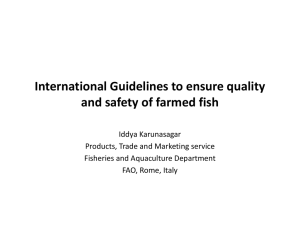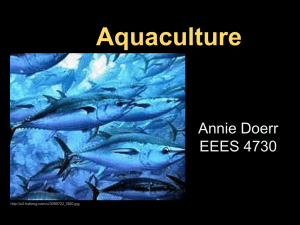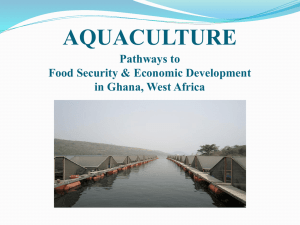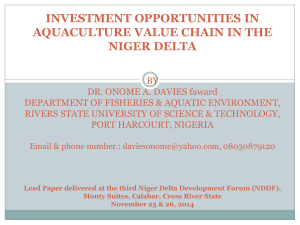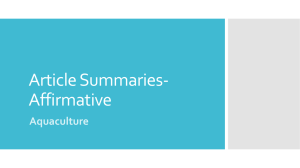AQUACULTURE AND TRADE - International Centre for Trade and
advertisement
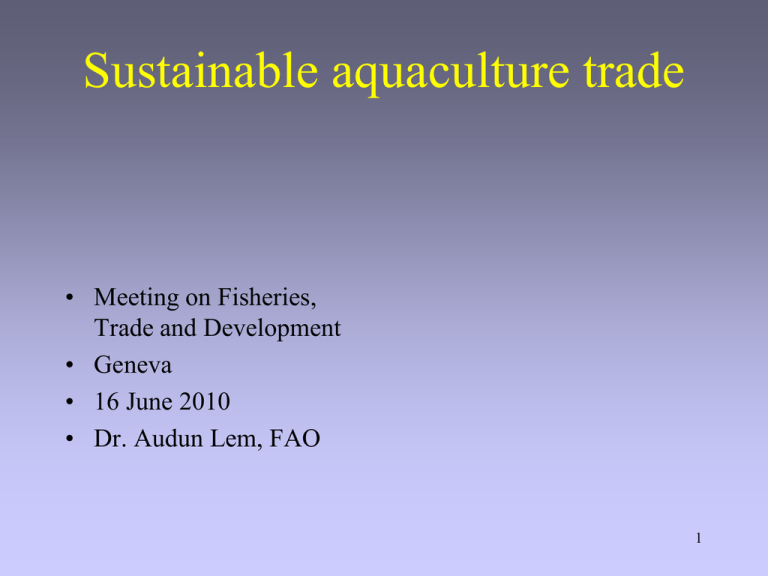
Sustainable aquaculture trade • Meeting on Fisheries, Trade and Development • Geneva • 16 June 2010 • Dr. Audun Lem, FAO 1 Outline • World fish supply and demand – – – – utilization and consumption trade prices distribution • Rise of aquaculture • Conclusions 2 WORLD FISH SUPPLY 3 World fish production Million t 2008 2009 2010e Capture 90 90 90 2010/ 2009 (0.1%) Farmed 53 54 56 3.1% Total 142 144 145 1.1% 4 World Fish Production 160 Millions of tonnes 140 120 Aquaculture Catch aquaculture 100 80 60 40 catch 20 0 1950 1953 1956 1959 1962 1965 1968 1971 1974 1977 1980 1983 1986 1989 1992 1995 1998 2001 2004 2007 2010 FAO 5 Fish Utilization 160 140 120 100 Feed 80 60 40 Food uses Other FEED FOOD 20 0 1996 1998 2000 2002 2004 2006 2008 2010 6 Per caput food supply (est) Kg/year 2008 2009 2010 2010/09 Food fish 17.1 17.1 17.1 0.2% Capture 9.3 9.2 9.1 -1.3% Farmed 7.8 7.9 8.1 1.9% 7 Fish in overall protein supply 8 World aquaculture production 19502010: strong growth but slowing down 60 Millions of tonnes Aquaculture 50 40 30 20 aquaculture 10 0 1950 1953 1956 1959 1962 1965 1968 1971 1974 1977 1980 1983 1986 1989 1992 1995 1998 2001 2004 2007 2010 9 Aquaculture producers 2008 China China India VietNam Indonesia Thailand Bangladesh Japan Chile Norway Rest 10 Global Aquaculture Production 70 China vs Rest of Asia 50 40 30 Production quantity (tonne x 106) Production quantity (tonne x 106) 60 Asia 60 China 40 20 0 1950 Rest of Asia 1970 Year 1990 Asia incl. China 20 10 Rest of World 0 1950 1960 1970 1980 1990 2000 Year 11 WORLD TRADE 12 World Fish Trade: Export Value - in 1000 USD 120,000,000 100,000,000 80,000,000 Developing countries or areas Developed countries or areas 60,000,000 developing 40,000,000 developed 20,000,000 0 1976 1979 1982 1985 1988 1991 1994 1997 2000 2003 2006 13 2009 WORLD FISH EXPORTS USD 102.2 BILLION (2008) • TRADE GROWING UNTIL ‘08 – + 9 % (2008/2007) • 2008 EXPORTS & IMPORTS > USD 100 BILL for 1st time • DEVELOPING COUNTRIES – 50 % OF WORLD EXPORTS • NET EXPORT REVENUES FROM FISHERIES CRUCIAL FOR MANY DEVELOPING COUNTRIES – USD 26 bill. (2008) 14 WORLD FISH EXPORTS USD 94.5 BILLION (2009est) • TRADE CRASHED IN 2009 (est 12 months) – - 7.5 % values – - 0.6 % volume (live weight conversion) • est. 2009 EXPORTS USD 94.5 BILLION • est. 2009 IMPORTS USD 98.6 BILLION • DEVELOPING COUNTRIES – 2009: 51.7 % OF WORLD EXPORTS 15 Share of world fisheries production destined to exports Million tonnes (live weight) 160 140 120 100 Production 80 Export 60 40 20 0 1976 1982 1988 1994 2000 2006 16 Main fish exporters 2008 (value) China 10% Norway 6% Thailand 6% USA 5% Viet Nam 4% Chile 4% EU (25) 26% Canada 4% Indonesia 2% Russia 2% 17 Main fish importers (2008) • • • • Japan US EU Total big 3 USD 14.5 bill. USD 14.1 bill. USD 45.0 bill. USD 73.6 bill. 13.8 % 13.5 % 46.8 % 68.1 % • Total world USD 108 bill. 100 % 18 Main fish importers (2009/2008) • • • • Japan US EU Total big 3 USD 13.2 bill. - 9 % USD 13.1 bill. - 7 % USD 39.5 bill. -13 % USD 65.8 bill. - 11 % • Total world USD 98.5 bill. -8.8% 19 Fish market trends • Japan: long-term decline but small rebound 2008, decline in 2009 – high consumption but falling: 65 kg/kaput – imports below 3 million tons in 2007 • USA: long-term growth, will overtake Japan as # 1 country – rising population and consumption /kaput 24 kg • consumer confidence falling late 2008 and 2009 • 2010 turn-around • EU: long-term growth: # 1 market – expanding population, stable consumption at 20 kg – rising imports: e.g. catfish from Viet Nam, mussels from Chile 20 Distribution • 66 % of world imports by three markets • within these markets: supermarkets represent 5085 % of retail sales • concentration of sales whereas industry remains fragmented • tendency in developing countries: urbanization • at the same time: seafood retail net margins reportedly low compared to other food products 21 Future ? • Supply side: more concentration in aquaculture for some species (salmon, European bass/bream, turbot. Shrimp ?) – focus on costs, economies of scale – focus on marketing and distribution – market and product segmentation • Demand: retail concentration in developed and developing • But aquaculture has some advantages over wild: – – – – standardized product, size traceability predictability contracts on price and volumes 22 ISSUES OF IMPACT 23 Global trend of outsourcing of both production and processing • Asia (China, Thailand, Viet Nam) • but also – Morocco (canning) – Poland/Baltic countries (marinades, smoking) • Growing share of production in developing countries, esp. of aquaculture – Europe, North America and Japan import farmed products from Asia, South And Central America 24 Role of China in production World capture and aquaculture production 160 140 China 100 80 60 World excluding China 40 20 2006 2001 1996 1991 1986 1981 1976 1971 1966 1961 1956 0 1951 Million tonnes 120 Year 25 The next China: Viet Nam • 2008: Nr 5 among world exporters – much of which is farmed: catfish, shrimp – but a growing importer as well • reprocessing • domestic consumption 26 Commodity prices • fish versus other food ? 27 Food prices, excl. fish 28 And fish ? Squid - In Italy, origin: South Africa Seabass and Seabream - In Italy, origin: Greece Squid - Who le, FA S, size M Seabass fresh who le 300-450 gr/pc EUR/kg EUR/kg Seabream fresh who le 300-450 gr/pc 7.00 6.0 6.00 4 .5 0 5.00 4 .6 0 5.0 4.0 3.0 Salmon - In Europe, origin: Norw ay 4 .3 5 Turbot - In Spain, origin: Spain Feb-10 Oct-09 Jun-09 Feb-09 Fresh - who le, cultured 0.5-1kg/pc 1-2 kg/pc 2-4 kg/pc 3-4 kg/pc Fresh, gutted, head-o n, 3-5 kg/pc EUR/kg Oct-08 Jun-08 Feb-08 Oct-07 Jun-07 Feb-07 Oct-06 2.0 Jun-06 Jun-10 Feb-10 Oct-09 Jun-09 Feb-09 Oct-08 Jun-08 Feb-08 Oct-07 Jun-07 Feb-07 Oct-06 Jun-06 3.00 Jun-10 4.00 EUR/kg 5 .5 0 6.0 5.5 5.0 4.5 4.0 3.5 3.0 2.5 2.0 9 .9 5 9 .0 0 8 .6 0 Jun-10 Feb-10 Oct-09 Jun-09 Feb-09 Oct-08 Jun-08 Feb-08 Oct-07 Jun-07 Feb-07 Oct-06 8 .15 Jun-06 Jun-10 Feb-10 Oct-09 Jun-09 Feb-09 Oct-08 Jun-08 Feb-08 Oct-07 Jun-07 Feb-07 Oct-06 Jun-06 Feb-06 Oct-05 Jun-05 Feb-05 Oct-04 Jun-04 19.0 17.0 15.0 13.0 11.0 9.0 7.0 5.0 29 19 94 19 01 95 19 -01 96 19 01 97 19 -01 98 19 01 99 20 -01 00 20 01 01 20 01 02 20 -01 03 20 01 04 20 -01 05 20 01 06 20 -01 07 20 01 08 20 -01 09 -0 1 The FAO Fish price index; (1998-2000 = 100) 180 160 140 120 100 80 60 FAO total fish price index Capture total Aquaculture Total 40 20 0 30 FUTURE FISH PRICES ? • DEMAND: slowly rising – because of population growth – small underlying increase in per kaput consumption • SUPPLY – capture: stable, not increasing – aquaculture: increasing but declining growth – unknowns: climate change, disease, but also technology improvements • PRICE IMPACT ? – most probably slightly higher fish prices but not much – price cycles in commodity markets – industry profitability through product development, technological innovation and cost reduction, targeted marketing 31 AQUACULTURE FUTURE • fastest growing food producing sector in the world • accounts for almost 50% of the global food fish • 53 million tons of fish produced worth USD 98 billion (2008) • Given the projected population growth, an additional 40 million tons of aquatic food needed by 2030 to maintain current per caput consumption. 32 Sustainable trade • Trade in fish is governed by WTO trade rules (NAMA) • Sustainability issues: – how to ensure sustainable production ? – how to ensure sustainable aquaculture development ? – how to ensure sustainable aquaculture trade ? 33 Aquaculture development • many countries prioritize an export driven aquaculture development – export markets, economic activities • but other elements are essential as well – social issues – environmental issues • for long-term sustainable growth, all three elements must be included – an ecosystem based development • NB: Aquaculture development is also a societal choice 34 FAO Guidelines • Responsible fish trade. FAO Technical Guidelines for Responsible Fisheries. No. 11. Rome, FAO. 2009 • Draft guidelines: The ecosystem approach to aquaculture (EAA) • Draft guidelines for Aquaculture certification – on agenda for COFI-AQ in September 2010 35 CONCLUSIONS • Fish has always been a globalized commodity – but of higher importance for developing countries than most other commodities • • • • • Fish production is increasing, but only thanks to aquaculture: 47% share in 2009 in food fish Fish trade trend is positive: USD 100 billion in 2008, but drop in 2009 New growth in trade in 2010 Fish trade: big 3 import 66 % but in decline Outsourcing of production and processing – Rise of China and Viet Nam, and Russia – Future: India ? • Aquaculture will determine overall future supply – the ecosystem approach to aquaculture focuses on the environmental context including the rights of stakeholders – sustainable aquaculture development must build on inclusion of economic, social and environmental criteria 36 THANK YOU 37
